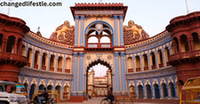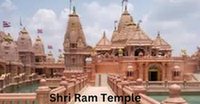Shri Ram Temple Ayodhya Uttar Pradesh India
Shri Ram Temple is being built at the birthplace of Lord Shri Ram in Ayodhya. This is a Hindu temple and has a centuries-old history. According to the Hindu religious text Ramayana, Shri Ram was born in the incarnation of Lord Vishnu. Shri Ram was the son of King Dasharatha of Ayodhya, who was a Hindu king. Shri Ram temple India.
Babri Masjid was built here during the Mughal rule around the 15th century. According to the Puranas, a mosque was built here after the demolition of a Hindu temple. Which also caused controversy. Shri Ram Temple Ayodhya Uttar Pradesh India.

The first phase of temple construction was started by Shri Ram Janmabhoomi Teerth Shetra Trust in March 2020. On August 5, 2020, the Bhoomi Pujan ritual was formally performed by Prime Minister Shri Narendra Modi. Shri Ram Temple Ayodhya Uttar Pradesh India.
Currently, decoration and construction work is going on in full swing in Ayodhya. The reason for this is that the idol will be installed in the temple on 22 January. Due to the possibility of a large number of people coming to this event, all preparations are being made. The Prime Minister of India, Shri Narendra Modi is its chief host. Shri Ram Temple India.
SNORING DISEASE-AYURVEDIC TREATMENT
Sun pillars and digital equipment are being installed at various places in Ayodhya, the city of Suryavanshi King Ram. A huge Jatayu statue made of bronze has also been installed in the temple premises. Maryada Purushottam Shriram Airport has started shining with lights. First of all, flight service to Delhi and Ahmedabad is ready to start from here. The beauty of the high-tech Ayodhya railway station is being built. After the consecration of Ram Lalla, devotees will start coming from all over the country, hence multi-level parking is also being built at many places. There will also be a facility to charge electric vehicles here. Apart from the airport, Bhakti Path, Rampath, Janmabhoomi Path, Dharma Path, etc. are also to be inaugurated in Ayodhya. The King of Thailand has sent soil from there for the consecration ceremony of Ram Lalla. Fragrant turmeric has come from Cambodia. Apart from this, 600 kg cow ghee has been sent from Jodhpur and Mithila art painting from Janakpur. In this painting, the events from Mother Sita’s birth on earth till her marriage with Lord Ram are depicted.

Special information – Shri Ram Temple India
- 1528-1529: Mughal emperor Babar built the Babri Masjid.
- 1850: Communal violence over land began.
- 1949: Ram idol was found inside the mosque, and communal tension intensified.
- 1950: Two cases were filed in Faizabad Civil Court for permission to worship idols.
- 1961: UP Sunni Central Waqf Board demanded the removal of the statue.
- 1986: The district court opens the site for Hindu worshippers.
- 1992: Babri Masjid was demolished on 6 December.
- 2010: Allahabad High Court ordered to division of the disputed area into three parts between the Sunni Waqf Board, Nirmohi Akhara, and Ram Lalla.
- 2011: The Supreme Court stayed the order of the Allahabad High Court.
- 2016: Subramanian Swamy files petition in Supreme Court, demands construction of Ram temple.
- 2019: The Supreme Court accepted that Ayodhya was the birthplace of Lord Ram, handed over the entire 2.77 acres of disputed land to the trust, and ordered the government to give 5 acres of land to the Sunni Waqf Board as an alternative site.
- 2020: PM Modi performed Bhoomi Pujan and laid the foundation stone.
- Ramlala’s life will be consecrated in the Ram temple of Ayodhya on January 22, 2024.
- More than 7000 special guests from across the country will attend this grand ceremony.
- The idol of Ramlala is made of stones from Karnataka and Rajasthan.
- About Rs 900 crore has been spent on the construction of Ayodhya Ram temple.
- The wood of the doors and windows has been brought from Ballal Shah of Maharashtra
- The carving on the doors and windows was done by workers from Hyderabad.
- Ramlala will be consecrated with water brought from holy rivers and wells across the country.
- The grand Ram temple will be completely ready in the year 2025
- On November 9, 2019, the Supreme Court gave its verdict in favor of Ram Temple.
- The King of Thailand has sent soil from there for the consecration ceremony of Ram Lalla.
- A flag pole of 44 feet in length and 500 kg will also be installed in the temple premises.
- Shri Ram Temple India.
Architect of Ram Temple
The first Ram Temple was designed in the year 1988 by the Sompura family of Ahmedabad. The people of the Sompura family have been designing temples for the last 15 generations and have designed more than 100 temples till now. When the construction of the Ram temple started in the year 2020, some changes were made to the old design of the temple and it was accepted and the temple is being constructed accordingly. Ram temple will be 235 feet wide, 360 feet long, and 161 feet high. This temple is being built in Nagar style. Nagara style is one of the architectural types of Indian temple construction. The main architects of this temple are Chandrakant Sompura and his two sons Nikhil Sompura and Ashish Sompura.
The architects have designed the prayer hall, Ram Katha Kunj, Vedic Pathshala, Sant Niwas, Yeti Niwas, museum, and cafeteria in the temple complex. These are also being constructed along with the temple. The Ram temple of Ayodhya will be very huge. It is being said that when this temple is completely ready, it will be the third-largest Hindu temple in the world.
The temple of Lord Ram is being built on 2.7 acres of land in Ayodhya. Which includes 54,700 square feet of land. The entire complex of Ram’s temple is being prepared in about 70 acres of land. There will be so much space in this complex that lakhs of devotees will be able to have the darshan of Lord Ram in the temple together. The construction work of the Ram temple is being done by Larsen & Toubro Company under the supervision of Shri Ram Janmabhoomi Tirtha Kshetra Trust. This temple is being constructed from the sandstone of Bansi mountain of Rajasthan.

Size and construction –
The size of the temple will be three times larger than the existing structure. The sanctum sanctorum of the temple will be octagonal, while the perimeter of the structure will be circular. The sanctum sanctorum is being constructed from Makrana marble. The temple will be 161 feet high and will have five domes and a tower. The temple is being made three-storeyed. The sanctum sanctorum has been designed so that the sun’s rays fall directly on Ramlala. Ramlala is the infant incarnation of Lord Shri Ram. The Griha Mandap, like the sanctum sanctorum in the temple, will be completely covered, while the Kirtan Mandap, Dance Mandap, Rang Mandap, and two prayer mandap will remain open.
Windows and doors will also be installed in the temple. All the doors and windows in the temple will be made of teak wood. This is a very strong wood whose age is around 100 years. These woods have been procured from Chandrapur, Maharashtra. The first consignment of wood has reached Ayodhya. After the rituals between June 26 and 30, the work of making windows and doors for the temple will begin. Windows and doors will be made by the hands of skilled artisans.
Idol of God
Two idols of God will be kept in the temple. There will be an original statue that was found in 1949 and has been in the tent for decades. The second one will be a big statue whose construction work is going on. For the construction of this idol, two Shaligram stones were brought to Ayodhya from Nepal. These stones were brought from the banks of the Kali Gandaki River flowing in the Mustang district of Nepal. It is being said that these rocks of Shaligram are six crore years old. The weight of these stones is 26 tons and 14 tons.
The rocks found on the banks of the Kali Gandaki River are famous. These are called Shaligram. In Sanatan Dharma, these stones are accepted as symbols of Lord Vishnu and are worshiped in every house. Champat Rai, General Secretary of Shri Ram Janmabhoomi Teerth Kshetra, had requested to make Lord Shri Ram idol from these rocks. Which has been accepted by the Trust and the people of India. Champat Rai has recently told the media that an idol of Lord Ram in his five-year-old form will be installed in the temple. The form of this idol has been taken from Valmiki Ramayana. He said that the construction of the sanctum sanctorum of the temple would be completed by September. Also, the idol of Ramlala will be made and ready by October.
Temple Bell
A huge bell weighing 2100 kg will be installed in the temple. Which will be 6 feet high and 5 feet wide. Apart from this, 10 small bells of different sizes will also be installed in the temple. Whose weight will be 500, 250, 100 kg. The bells would be manufactured by mixing brass with other metals. These watches are being manufactured by Jalesar, Etah-based firm Savitri Traders. Etah’s Jalesar is famous all over the world for its Ghungroo and bell industry. The people here have been making these things from generation to generation. Bells made by Jalesar are installed in many temples of the country.

